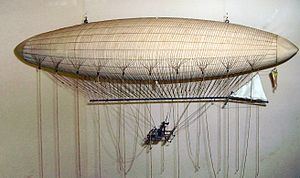Top speed 9 km/h First flight 1852 | Length 44 m | |
 | ||
The Giffard dirigible or Giffard airship was an airship built in France in 1852 by Henri Giffard, the first powered and steerable (French: dirigeable - "directable") airship to fly. The craft featured an elongated hydrogen-filled envelope that tapered to a point at each end. From this was suspended a long beam with a triangular, sail-like rudder at its aft end, and beneath the beam a platform for the pilot and steam engine. Due to the highly flammable nature of the lift gas, special precautions were taken to minimise the potential for the envelope to be ignited by the engine beneath it. The engine's exhaust was diverted downwards to a long pipe projecting below the platform, and the area surrounding the boiler's stoke hole was surrounded by wire gauze. On 24 September 1852, Giffard flew the airship from the hippodrome at Place de l'Etoile to Élancourt, covering the 27 km (17 mi) in around 3 hours, demonstrating maneuvering along the way. The engine, however, was not sufficiently powerful to allow Giffard to fly against the wind to make a return journey.
Specifications
General characteristics
Performance
